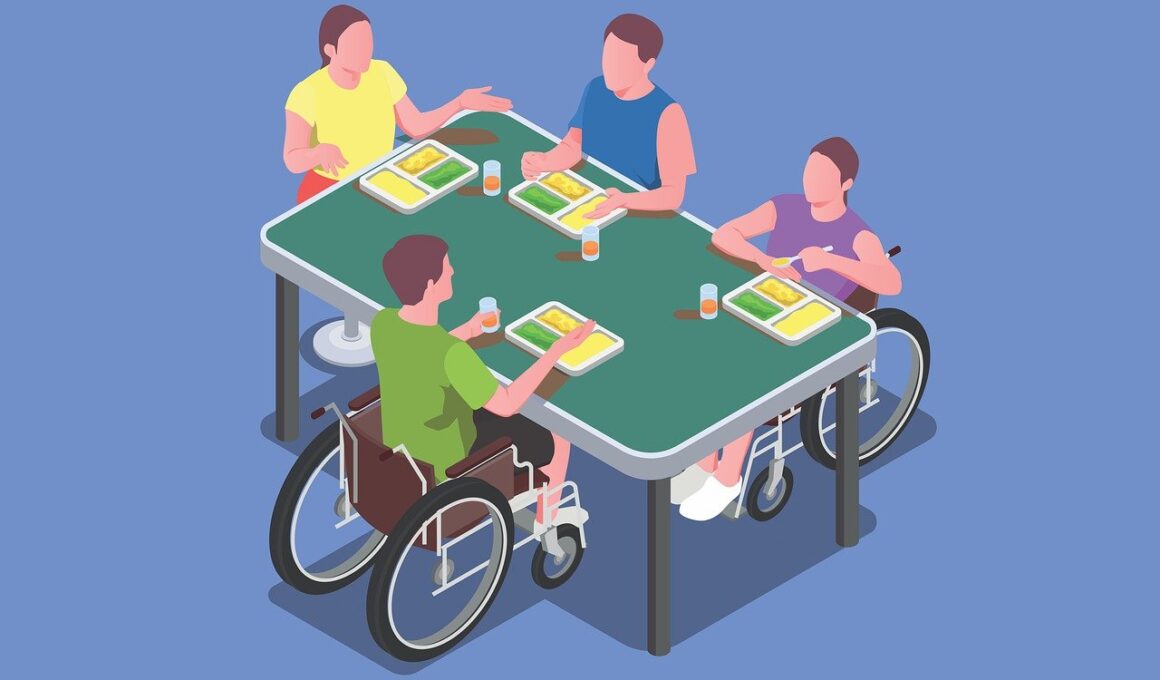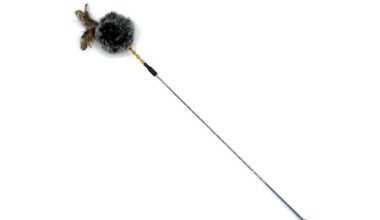Modifying Flyball Courses for Dogs with Mobility Challenges
Flyball is an invigorating sport that pets and owners love. However, for dogs with mobility challenges, conventional Flyball courses may present obstacles. Modifying these courses ensures participation and enjoyment for all. Recognizing the unique abilities of each dog is essential in crafting a welcoming environment. Collaboration with veterinarians can help in understanding specific needs. Various adjustments can facilitate a positive experience for disabled dogs. For example, you could reduce the height of jumps, allowing those with limited mobility to engage more comfortably. Soft surfaces can also minimize the risk of injury when dogs land after a jump. It’s crucial to encourage gradual acclimatization, ensuring that dogs feel secure on the course. Including ramps instead of jumps for dogs that may need additional support will enhance their overall experience. Additionally, utilizing adaptive equipment like harnesses can promote easier navigation in runs. Overall, creating an accommodating atmosphere helps disabled dogs thrive while enjoying Flyball. This sport holds inclusive potential to bring happiness to both dogs and their owners, further strengthening the bond shared. While adjustments are necessary, the joy evident in these dogs makes the effort absolutely worthwhile.
To further enhance your Flyball course for dogs with mobility challenges, consider the layout. Designing a more straightforward course with fewer obstacles will benefit participants. Instead of complex relay setups, try implementing a more linear track that accommodates these dogs. The design may include wider pathways for easier navigation. Marking areas with clear visuals can guide the dogs and handlers, reinforcing positive behaviors during practice. Additionally, educating participants and their owners on proper techniques can be vital. Teaching them how to support their dogs appropriately and engaging them in positive reinforcement strategies will create a more enjoyable atmosphere. This method ensures that dogs will feel confident and secure throughout the competition. It is essential to pay attention to the specific limitations of each dog. Owners may note when their dogs show signs of discomfort or excessive fatigue. Acknowledging these signals can help adjust pace and expectations during events. Moreover, providing ample breaks during competitions will rejuvenate the dogs, helping emotionally and physically. Involving trainers who specialize in canine disabilities will further assure everyone involved feels confident and secure. Thus, the enhancements pave the way for success in the competitive setting, celebrating each dog’s unique effort.
Community Involvement and Support
Encouraging community involvement is fundamental to establishing successful Flyball modifications. Reaching out to local dog clubs can create awareness and foster collaboration. Various stakeholders, including trainers, veterinarians, and pet owners, play pivotal roles in this initiative. By combining resources, you can devise innovative strategies for modifying courses that accommodate disabled dogs effectively. Community events focused on raising funds for adaptive dog sports can also prove beneficial. Workshops aimed at educating participants about mobility challenges and potential adaptations can strengthen support networks while enhancing skills. Additionally, these gatherings promote bonding experiences between owners and dogs, leading to emotional benefits for both. Strengthening bonds among owners and their pets fosters a sense of responsibility. Providing an inclusive environment for all dogs contributes greatly to their morale and spirit. Engaging local businesses to sponsor events or contribute adaptive equipment may also be advantageous. Ultimately, collaboration can transform the competitive landscape into an accessible one. As supporters rally around modifications, they are empowering relationships for the better. With resources pooled, Flyball can evolve into a sport that is genuinely inclusive, showcasing the remarkable abilities of all dogs regardless of their mobility challenges.
Creating various training programs tailored specifically for disabled dogs is crucial for their development. Implementing classes that focus on basic obedience and flyball-specific skills can be beneficial. These programs should consider varying mobility levels to ensure inclusivity and effectiveness. For example, utilizing slow-paced sessions may better accommodate dogs that struggle with speed. Additionally, introducing games that focus on teamwork makes training fun while fostering bonds between pets and owners. These playful interactions keep training enjoyable, reducing stress for both participants. Encouraging owners to share their experiences within the community can spark motivation and creativity in training. By exchanging ideas on workable adaptations, attendees can collaborate on helpful techniques. Utilizing online platforms allows owners to engage with one another, sharing success stories and strategies. Online communities can serve as critical resources for ongoing support, knowledge sharing, and encouragement. At each level, the adaptability of a dog remains a defining quality. Personalized training ensures that dogs accomplish their goals, making significant progress over time. Therefore, providing opportunities for growth guarantees lasting positive experiences in Flyball, as they take pride in their achievements while participating in activities tailored to fit their unique needs.
Safety Measures for Disabled Participants
Ensuring the safety of all participants, especially for disabled dogs, is paramount in Flyball events. Various safety measures can prevent injuries and create a secure environment for everyone. Providing clear guidelines for course modifications is essential to direct handlers on how to approach obstacles safely. Furthermore, assessments of dog health before participation in events safeguard their well-being, emphasizing the importance of having a veterinarian’s approval. In addition, having first-aid resources readily available at each event is a critical factor. Training volunteers or staff members on how to handle emergencies smoothly can save valuable time. It is necessary to establish contingency plans for reacting to unexpected situations. Participants should be made aware of reporting procedures for any concerns regarding course conditions that may pose hazards. Continuous grooming of the venue and equipment keeps it in optimal conditions, ensuring that dogs can navigate smoothly. Additionally, encouraging owners to monitor their dog’s energy levels throughout the competition is crucial. Providing hydration stations along the course helps maintain well-being. These measures contribute to a balanced atmosphere, ensuring a positive experience for both owners and dogs. Ultimately, integrating safety and enjoyment supports an environment that celebrates adaptability.
The role of technology cannot be overlooked when modifying Flyball courses for dogs with mobility challenges. Innovations such as mobility aids and adaptive equipment can greatly benefit participants. For instance, mobility support harnesses might allow disabled dogs to navigate courses more comfortably. These tools empower confident participation, making a difference for dogs struggling with mobility issues. In addition, technology advancements offer electronic timing systems that can track performances accurately. This data can help owners better understand their dog’s pace and capabilities, leading to more tailored training approaches. Moreover, using app-based systems allows for real-time communication between handlers and trainers during events. By fostering connections, any concerns about the dog’s performance can be addressed immediately. Consequently, regular updates can keep owners informed about their dogs’ progress. Furthermore, incorporating video demonstrations of successful modified runs showcases best practices to inspire and motivate owners. Videos can serve as valuable educational tools, providing insight into adaptive strategies. Therefore, embracing technology seeks to democratize access and participation, ensuring every dog has a chance at excelling in Flyball. Assuredly, technology plays a crucial role in enhancing inclusivity within canine sports while celebrating the remarkable abilities of all participants.
Conclusion: Celebrating Inclusivity in Dog Sports
In conclusion, adjusting Flyball courses for dogs with mobility challenges allows a brighter future for canine sports. This approach empowers dogs of all abilities to participate, fostering community and emotional growth among handlers. By focusing on safety, education, and community involvement, we push the sport toward a more inclusive model. Important considerations include adapting equipment to ensure safety and comfort for participants, thus cultivating a supportive environment. Moreover, the role of community collaboration cannot be overstated, as it leads to improved knowledge-sharing and shared resources among stakeholders. Ensuring ongoing training programs that address the needs of disabled dogs contributes to skill development as well. As we embrace technology and innovations, the evolution of Flyball continues to inspire both dogs and their owners. Celebrating the unique contributions of all canine athletes enhances the experience, showcasing their astounding resilience despite any challenges they may face. As the Flyball community continues to grow, inclusivity remains at the heart of its mission. Ultimately, the modifications promote a thriving environment for both dogs and their owners, ensuring that everyone can shine on the field, regardless of their mobility capabilities.
In conclusion, adjusting Flyball courses for dogs with mobility challenges allows a brighter future for canine sports. This approach empowers dogs of all abilities to participate, fostering community and emotional growth among handlers. By focusing on safety, education, and community involvement, we push the sport toward a more inclusive model. Important considerations include adapting equipment to ensure safety and comfort for participants, thus cultivating a supportive environment. Moreover, the role of community collaboration cannot be overstated, as it leads to improved knowledge-sharing and shared resources among stakeholders. Ensuring ongoing training programs that address the needs of disabled dogs contributes to skill development as well. As we embrace technology and innovations, the evolution of Flyball continues to inspire both dogs and their owners. Celebrating the unique contributions of all canine athletes enhances the experience, showcasing their astounding resilience despite any challenges they may face. As the Flyball community continues to grow, inclusivity remains at the heart of its mission. Ultimately, the modifications promote a thriving environment for both dogs and their owners, ensuring that everyone can shine on the field, regardless of their mobility capabilities.


